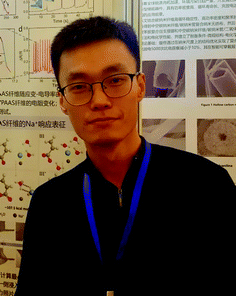Materials Horizons Emerging Investigator Series: Dr Chengyi Hou, Donghua University, China
Chengyi Hou is an associate professor at the State Key Laboratory for Modification of Chemical Fibers and Polymer Materials, Donghua University, China. He received his PhD degree from Donghua University in 2014. He worked at the Department of Chemistry, Technical University of Denmark from 2015 to 2017, under the Hans Christian Ørsted Postdoc Programme, and was awarded a Marie Curie Fellowship. After joining Donghua University, he was awarded the Donghua University Distinguished Young Professor Fellowship, Shanghai Rising-Star, and Young Top-notch Talents.
He has engaged in the development of innovative methods and experimental approaches to address key scientific and technical challenges related to scalable synthesis, processing and assembly of smart fibers and fabrics. These novel materials realize sensory and actuatory tasks like health monitoring, thermal and moisture management, energy harvesting, and human–machine interaction. Their potentialities in next-generation clothing have also been explored.
Based on the above research, Chengyi Hou has edited one book on smart clothing (Wiley-VCH) and has published over 60 peer-reviewed journal articles, with several publications in Science Advances, Nature Communications, Advanced Materials, Materials Horizons, amongst others.
Read Chengyi Hou's Emerging Investigator Series article ‘Scalable fluid-spinning nanowire-based inorganic semiconductor yarns for electrochromic actuators’ (DOI: 10.1039/D1MH00135C ) and read more about him in the interview below:
MH: Your recent Materials Horizons Communication reports a unique fluid-spinning strategy to obtain a series of highly oriented inorganic nanowire-based semiconductor yarns. How has your research evolved from your first article to this most recent article and where do you see your research going in future?
CH: My first article was published in 2010, at that time, my earlier research focused on the synthesis of metal oxide nanomaterials and their contributions to the functionalization of graphene nanosheets. Some of the metal oxide/graphene hybrid nanomaterials were found to be sensitive to environmental stimuli. Inspired by this, since 2012 we started trying to assemble them into macroscopic one-dimensional (1D) (i.e., fibers and yarns), 2D (i.e., films), and 3D (i.e., hydrogels) forms to enable environmentally-responsive wearable materials. What attracted me most was the actuating behaviors of smart fiber materials, because actuating fibers can mimic both morphology and function of natural muscle fibers. In addition to graphene and its derivatives, various materials were then used in assembling actuating fibers, including carbon nanotubes, metals, semiconductor nanowires, hydrogels, etc. Among those, inorganic semiconductors are brittle and lack flexibility, which limits their possibilities to make macroscopic fiber assemblies. It is not impossible but just needs more tricks. For instance, both orientation of the raw nanomaterials and hierarchical order of micro-structures were found to be critical for inorganic semiconductor fiber formation, but existing fiber spinning methods can hardly be applied to inorganic semiconductor fibers. We solved this problem and reported our new strategy in this Materials Horizons Communication. Readers will also see that the semiconductor fiber (yarn) reported here is able to change its color along with actuating due to its unique semiconductor characteristics; this visualized sensory behavior is entirely new to actuating fibers. Encouraged by this work, we will keep exploring the smart fiber family, and hopefully will introduce many other interesting smart fibers to the readers in the near future.
MH: What aspect of your work are you most excited about at the moment?
CH: I am excited about achieving a novel fiber spinning strategy that enables scalable production of new semiconductor fibers (yarns), so that we could enjoy discovering their interesting properties that are unknown before.
MH: In your opinion, what are the most important questions to be asked/answered in this field of research?
CH: How will smart fibers change our lives? I think this question will guide the development of fiber materials. How to spin a fiber from unconventional raw materials (e.g., inorganic semiconductor nanomaterials) or in an unusual environment (e.g., on Mars)? The answer to this question may open a door to novel fiber technologies and new industry. Besides, a fundamental understanding of the relationship between raw material properties and fiber performance is highly important for the development of novel fibers and fabrics.
MH: What do you find most challenging about your research?
CH: From Lab to Fab, it has always been a critical challenge in materials science. Especially in the field of smart fibers and fabric materials, crucial questions are often asked: Are smart fibers and fabric really as scalable, washable, wearable, and comfortable as conventional ones? To answer these questions, tests that meet practical needs are expected to be presented in our research papers. This requires both fundamental and applied research, and usually involves fabrication and investigation of industrial products instead of demos. We have to think beyond the textbook and literally go out of labs to make creative engineering work. This is full of challenges but also exciting!
MH: In which upcoming conferences or events may our readers meet you?
CH: I will definitely participate in the Chinese Materials Conference 2021, July 8–12, 2021. I will introduce our latest results on sensory fibers during this conference.
MH: How do you spend your spare time?
CH: Watching movies to “experience” different kinds of life. By the way, my research on smart fibers was partly inspired by the super-suit from superhero movies.
MH: Can you share one piece of career-related advice or wisdom with other early career scientists?
CH: Stick to your research interests, but never stop learning new knowledge in order to see things in a new light. More importantly, make sure you are happy and excited with your daily work.
| This journal is © The Royal Society of Chemistry 2021 |

